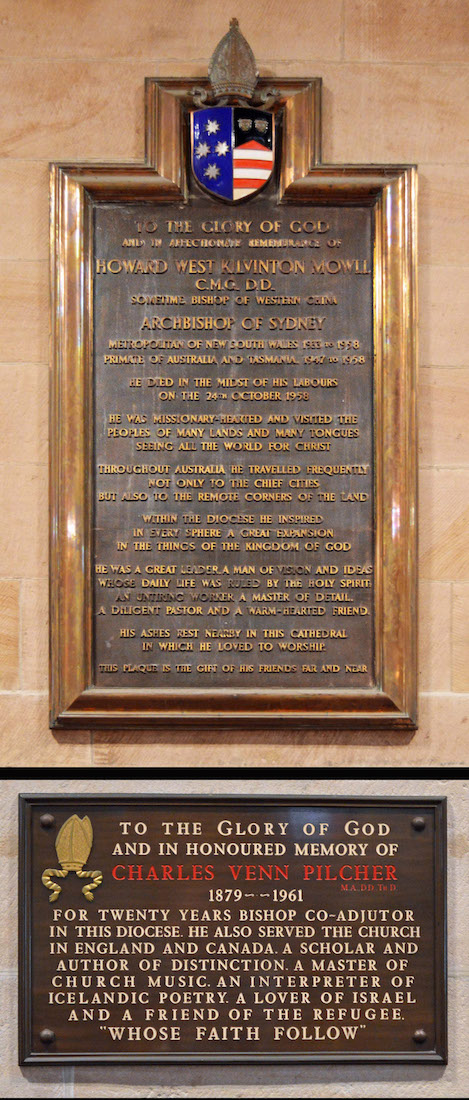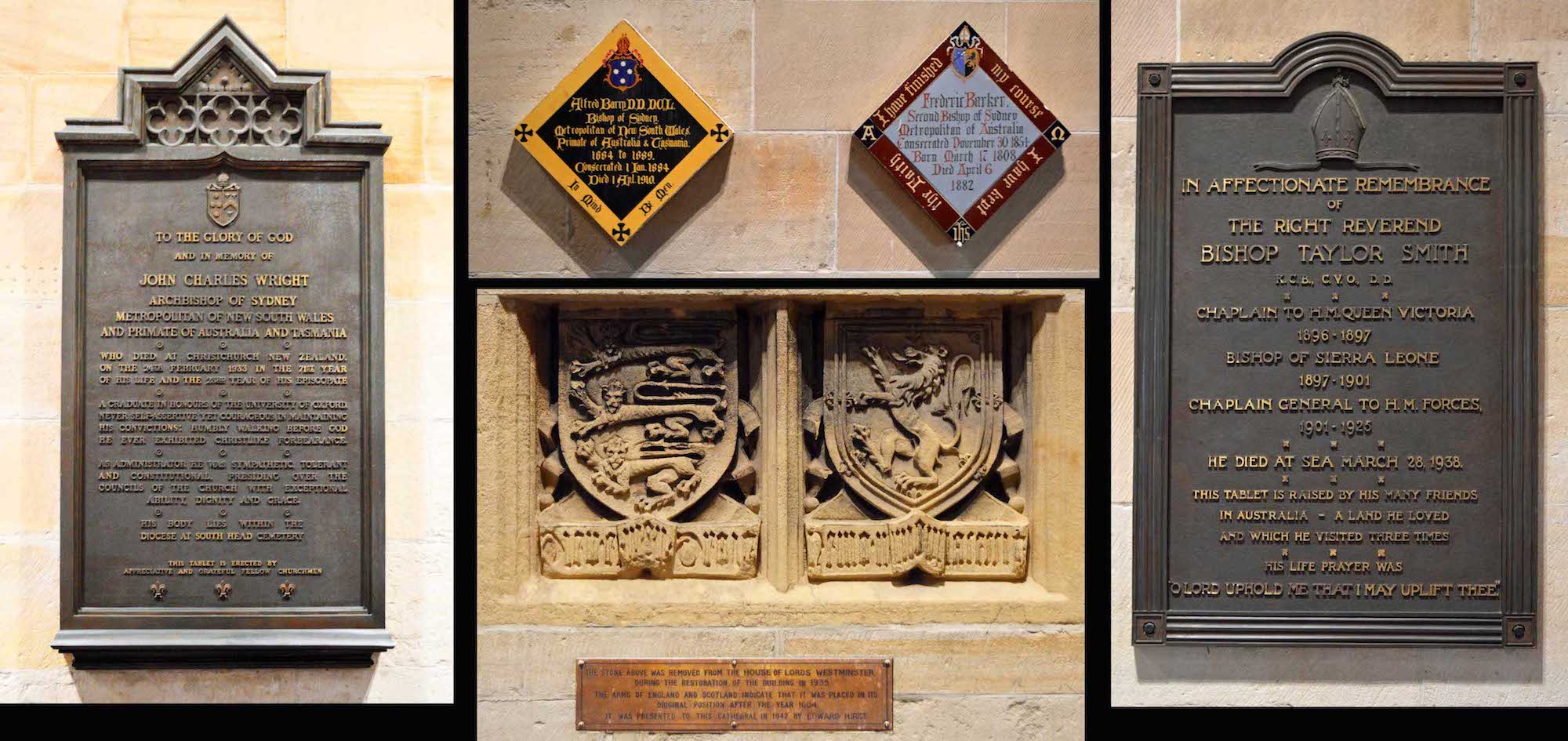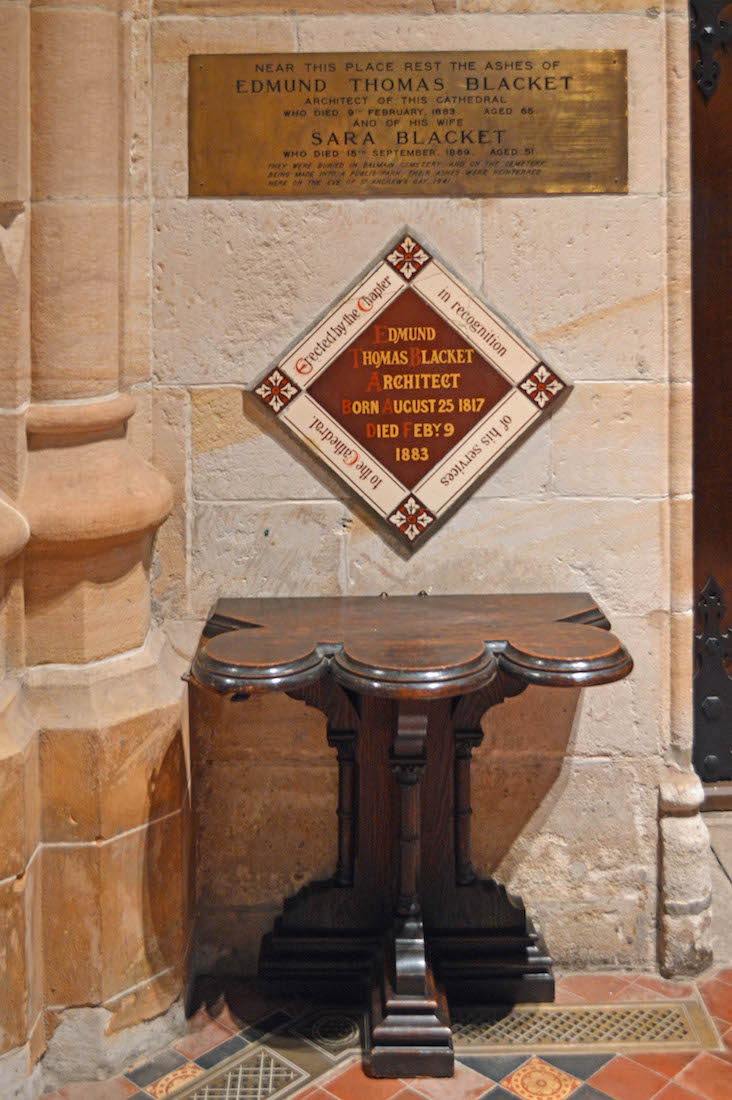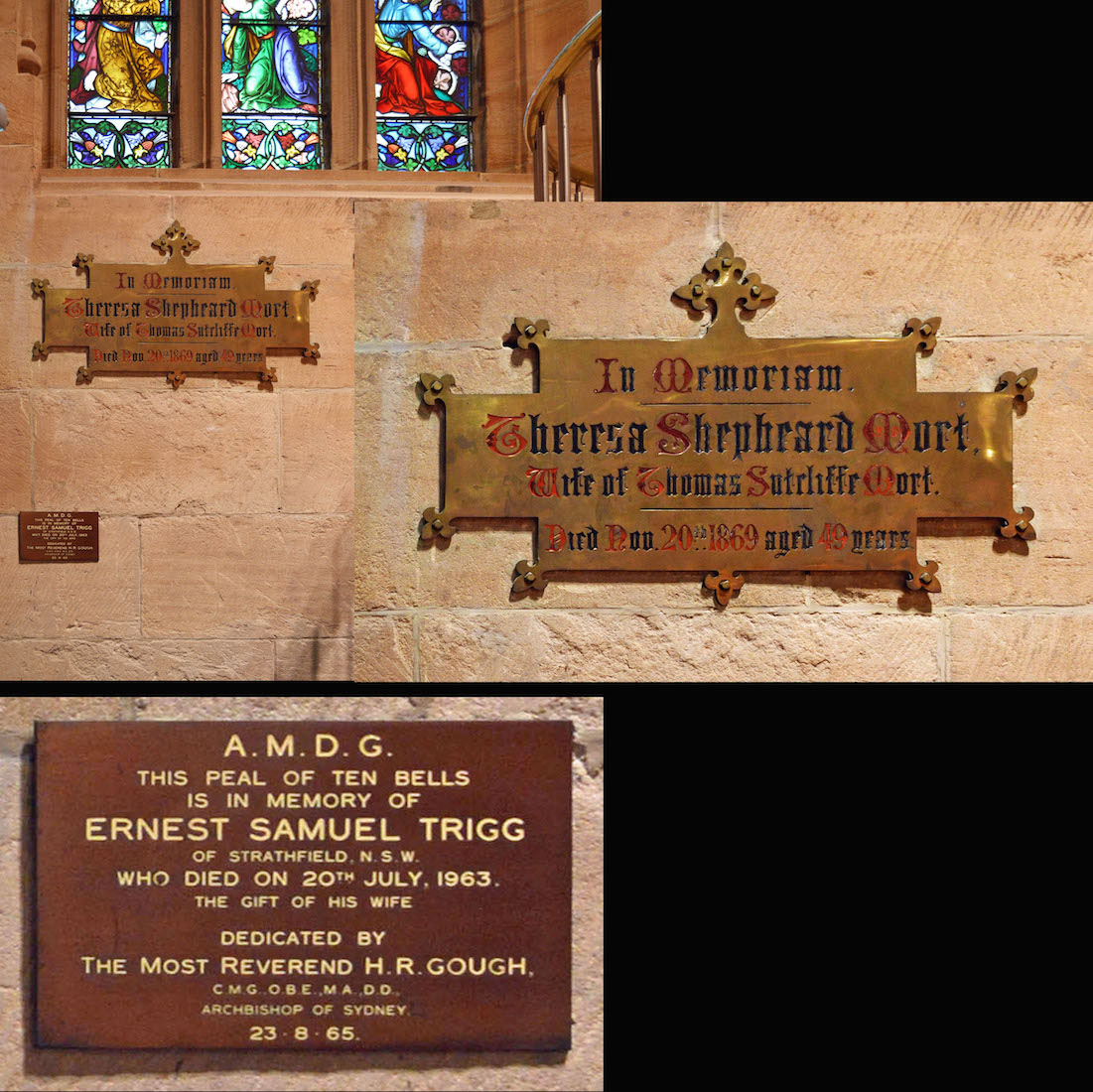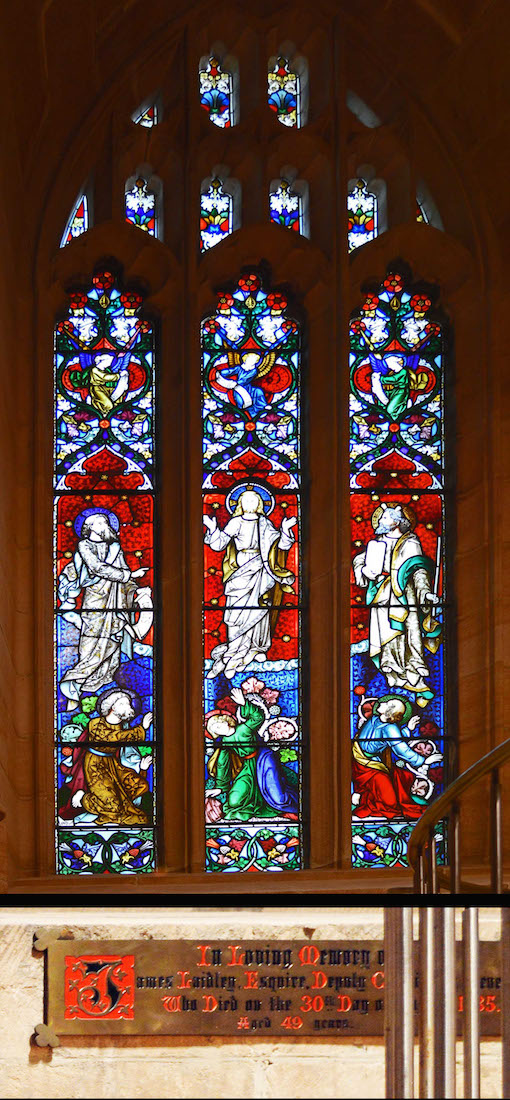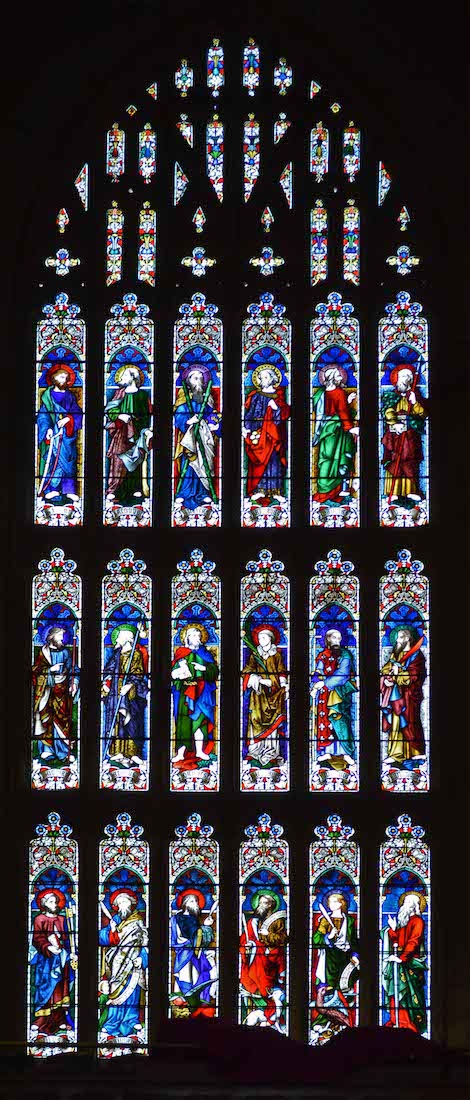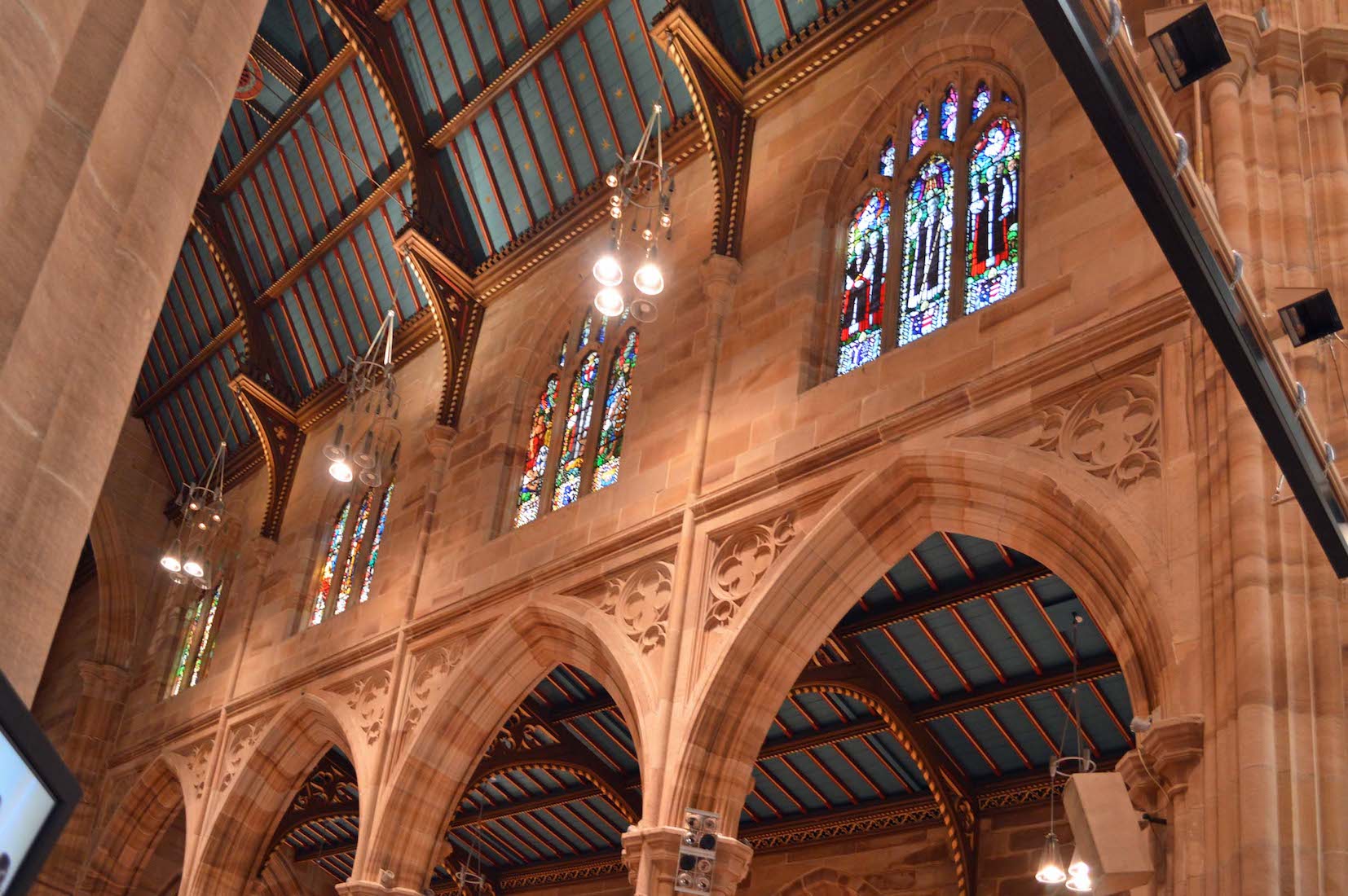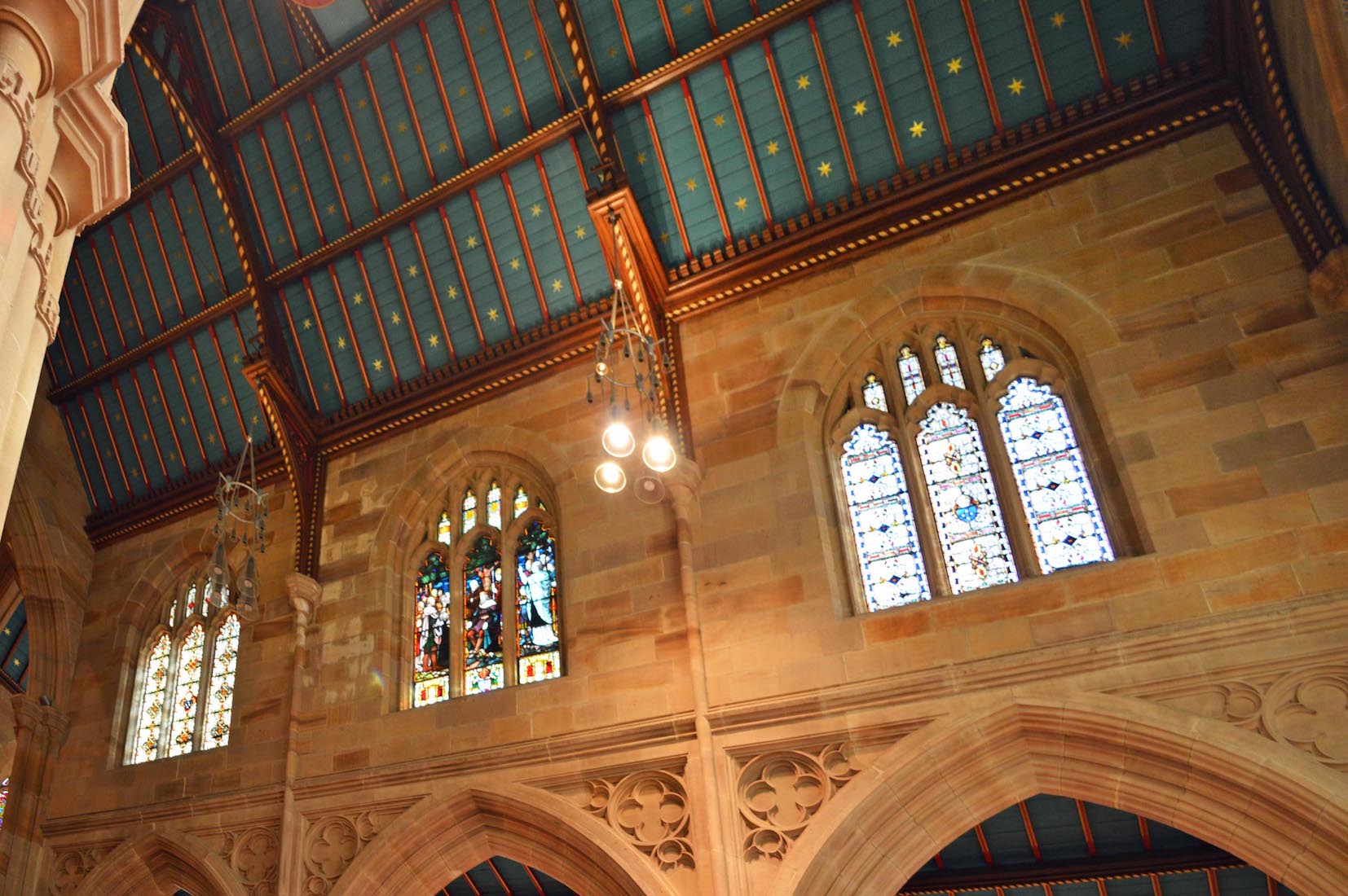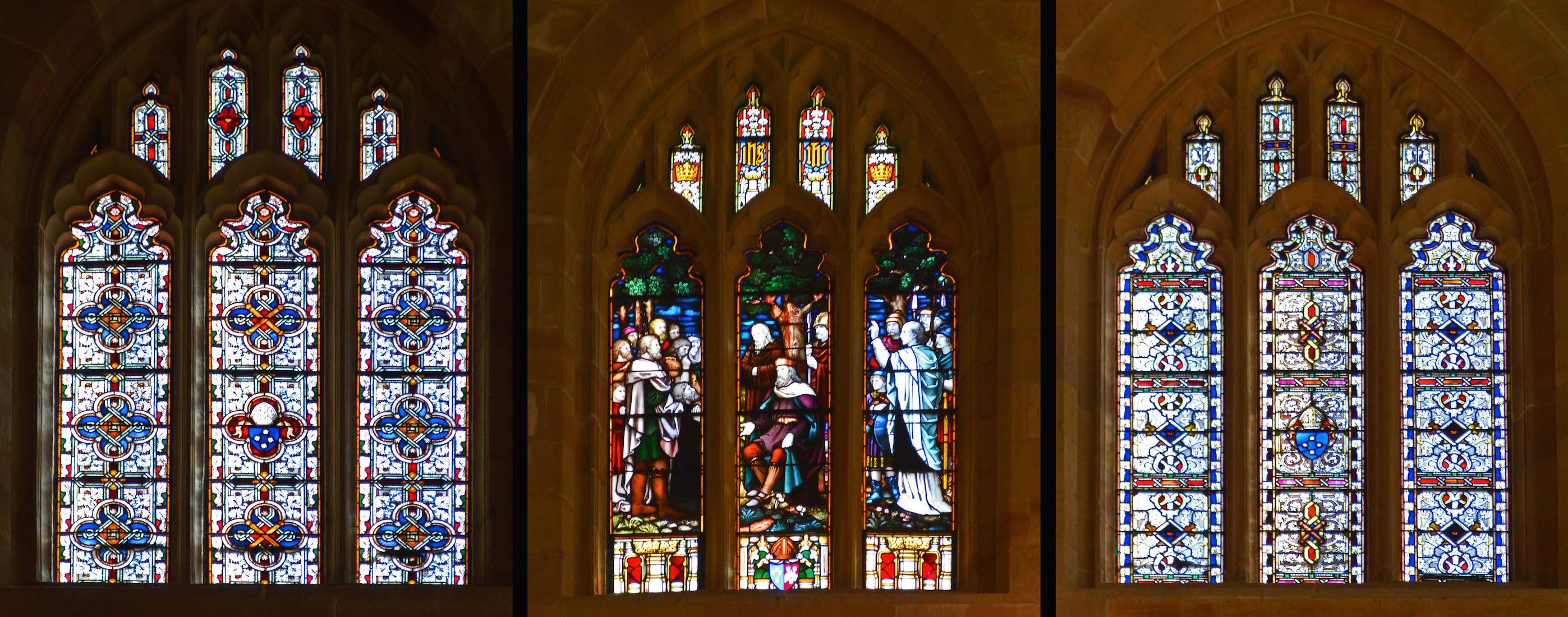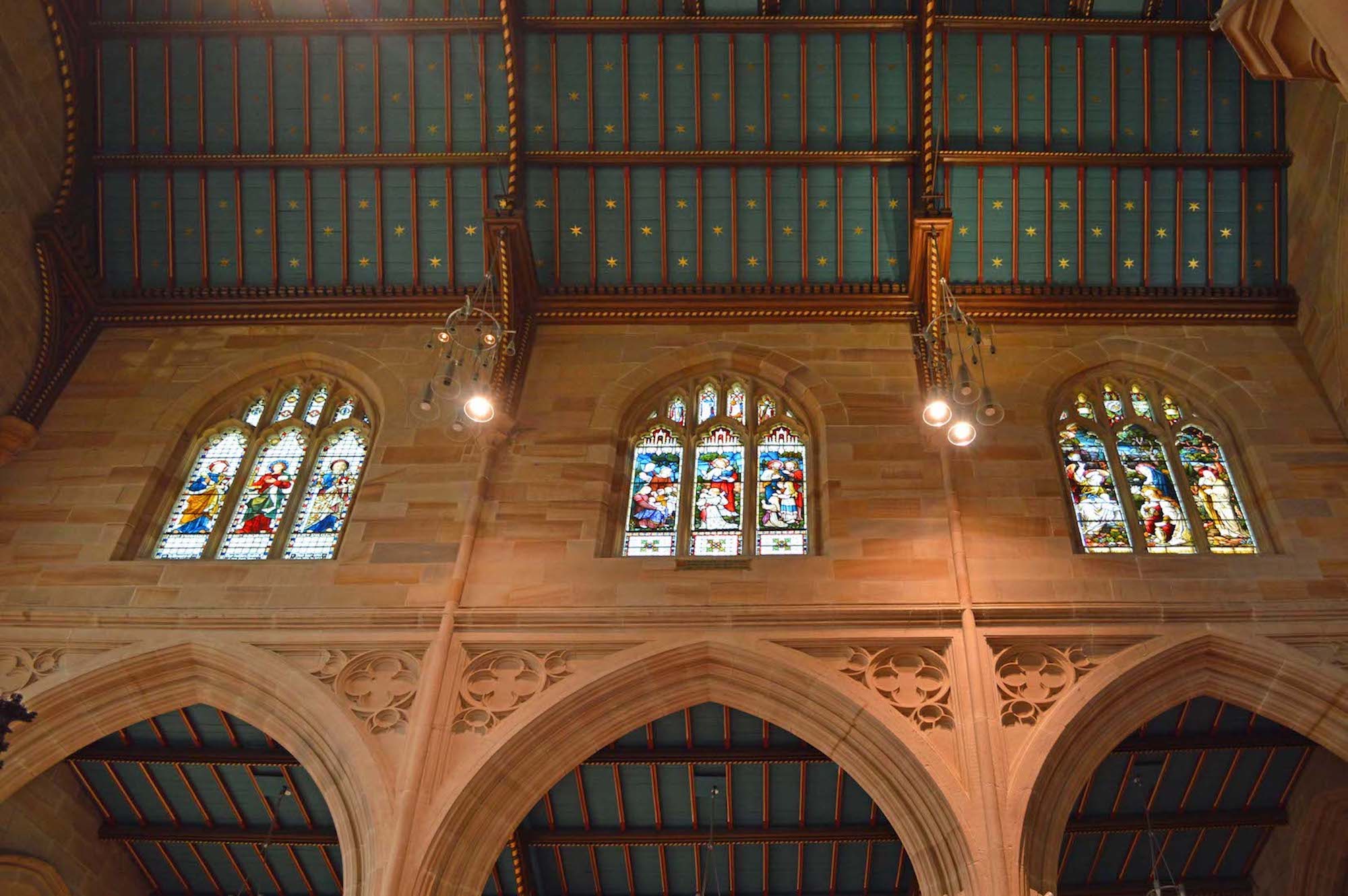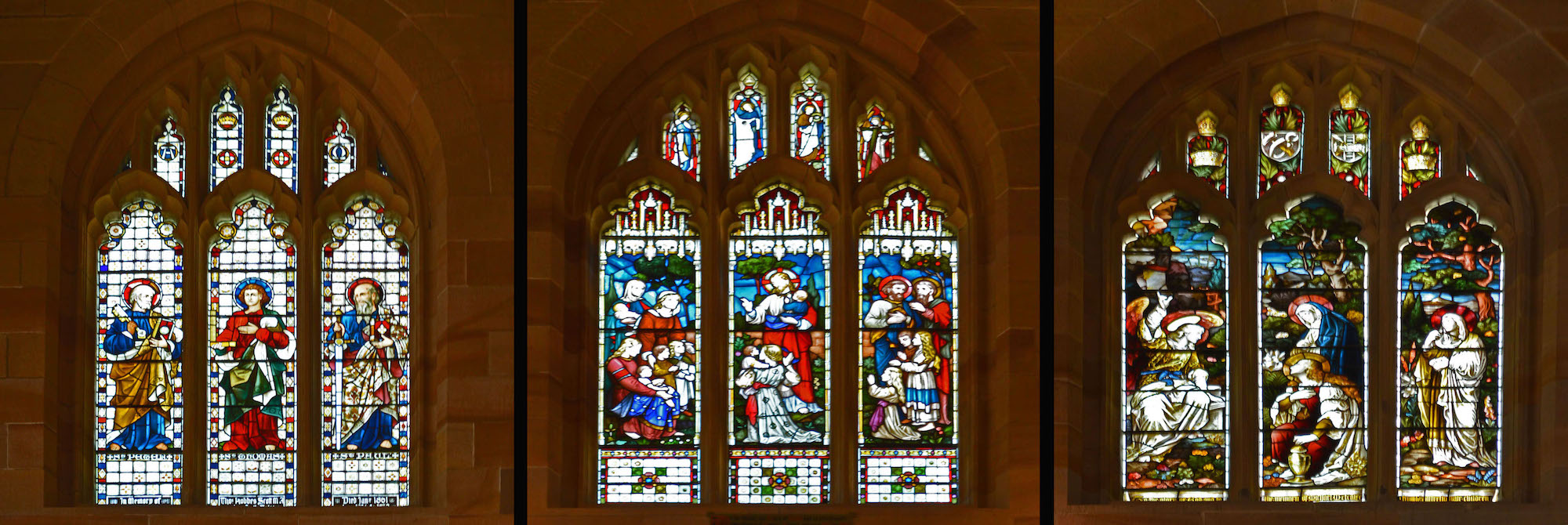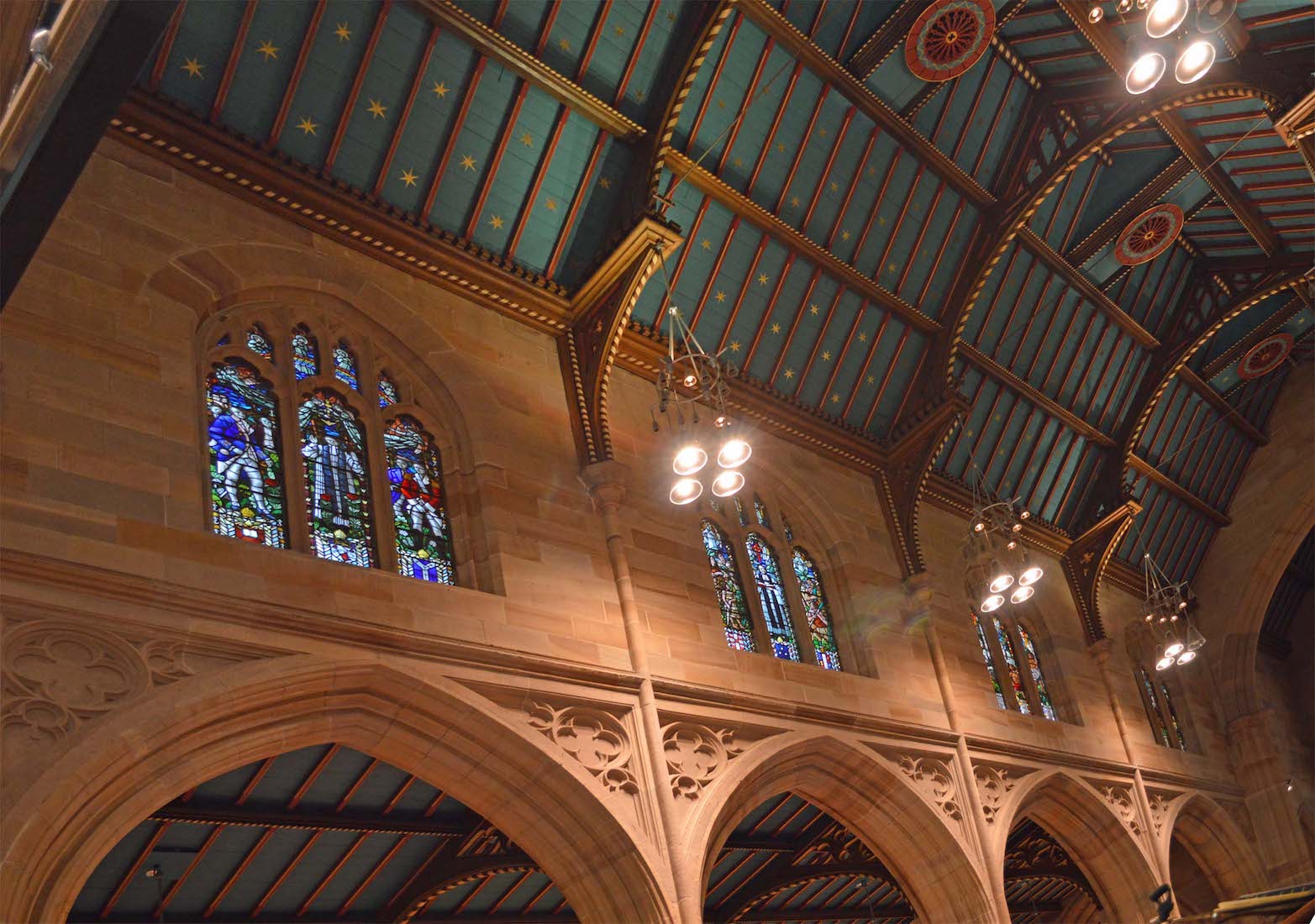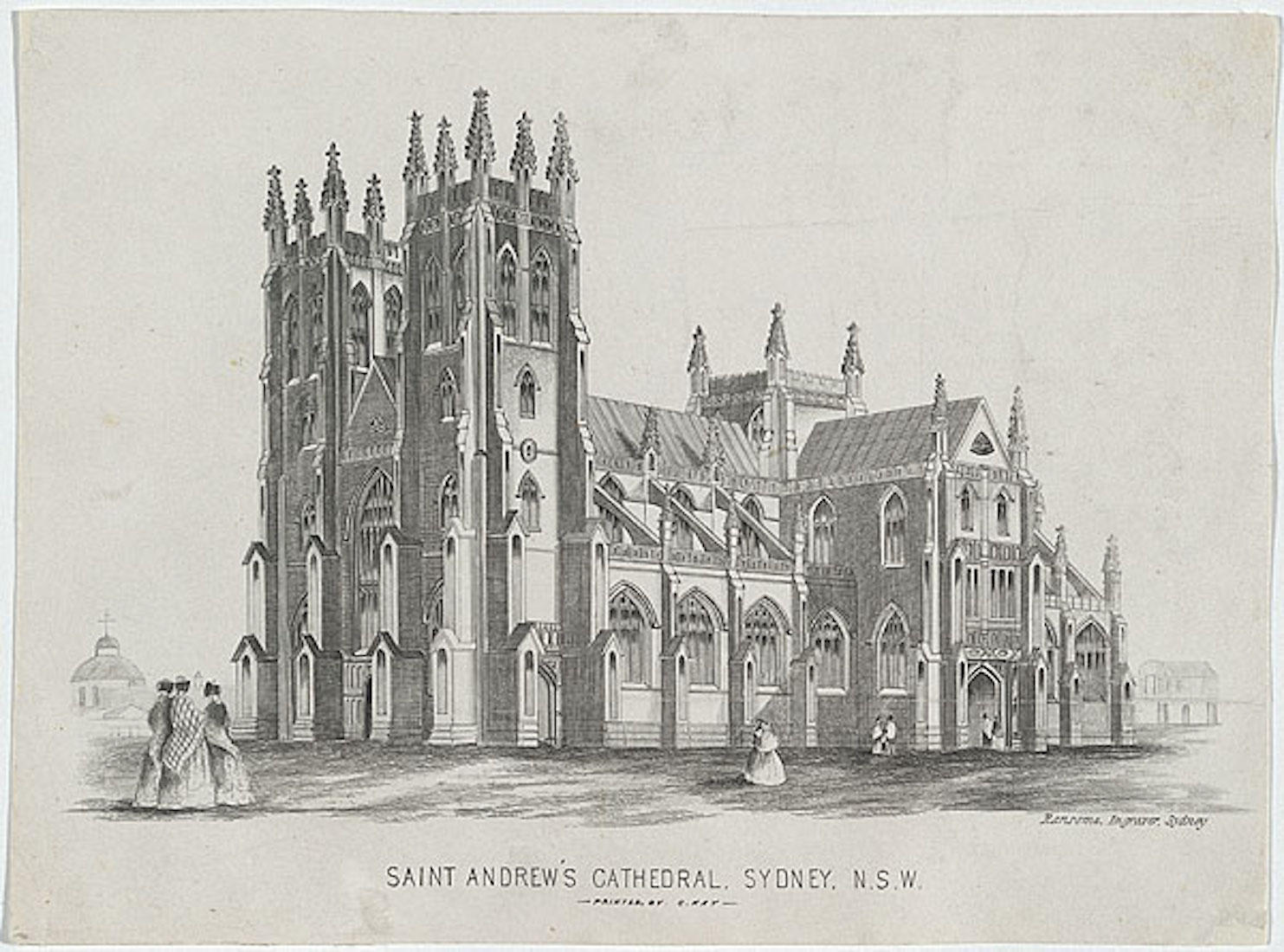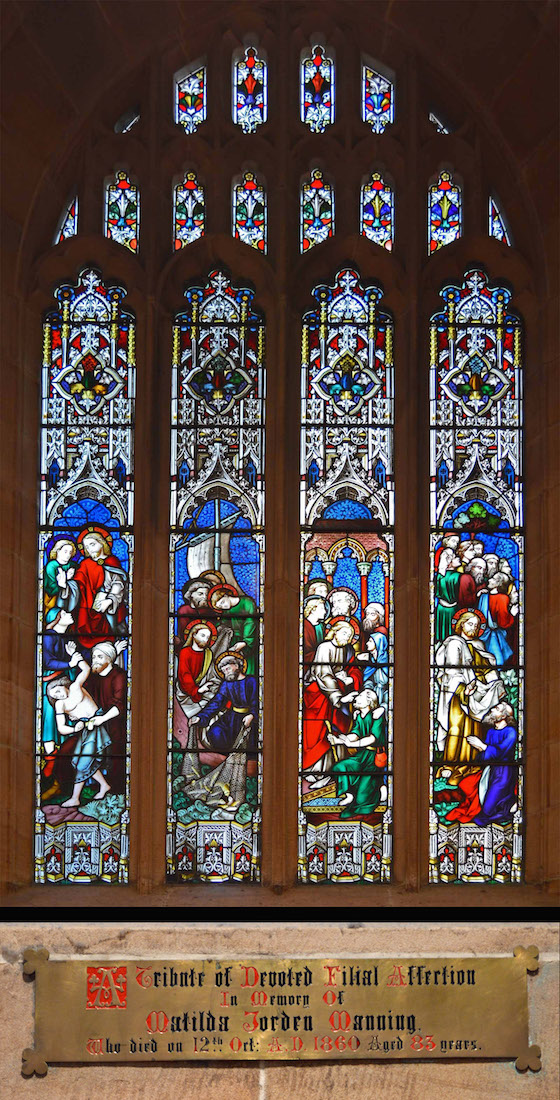
Window 2 continues the Miracles theme. The panels show (from left to right): • Jesus casting out a devil (Luke 11:14), • a catch of fish (John 21:1 – 6), • A blind man sees (Mark 8:22 – 25), and • Jesus healing ten lepers (Luke 17:11 – 19). The plaque below the window reads: A tribute of devoted filial affection. In memory of Matilda Jorden Manning who died on 12th Oct AD 1860, aged 83 years. PLAN
62. UNDER WINDOW 2
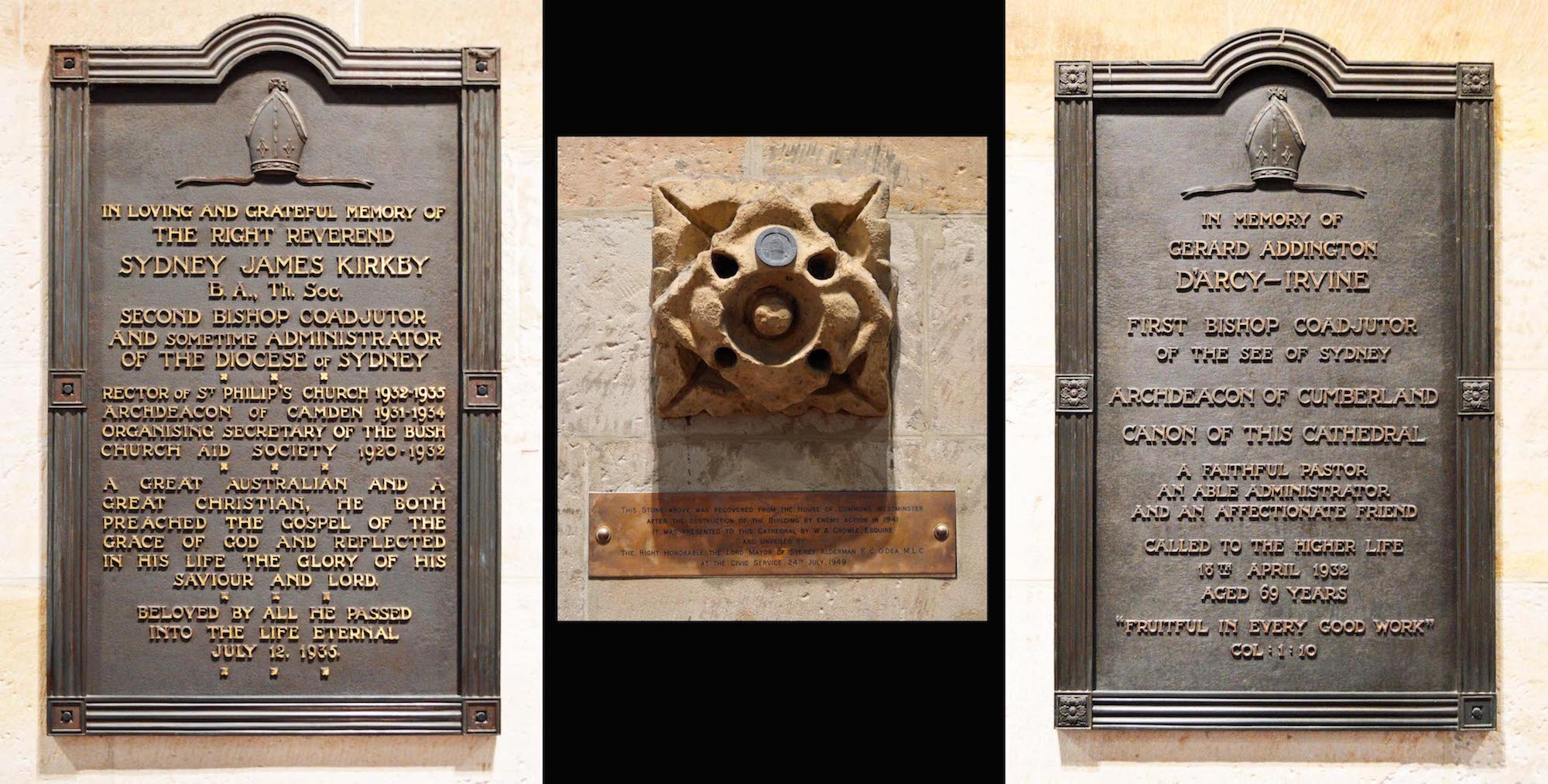
The central stone was recovered from the Westminster House of Commons after the 1941 bombing of London. The outer plaques commemorate the lives of • The Right Reverend Sydney James Kirby B.A., Th. Soc., second Bishop Coadjutor and sometime Administrator of the Diocese of Sydney; • Gerard Addington D’Arcy - Irvine, first Bishop Coadjutor of the See of Sydney, Archdeacon of Canberra, Canon of this Cathedral.
63. SOUTH NAVE PLAQUES
62. More plaques! The top one commemorates the life of Howard West Kilvinton Mowll, Metropolitan of NSW See 1933 – 1948. Primate of Australia and Tasmania 1947 – 1958. He was missionary hearted and visited the peoples of many lands and many tongues, seeing all the world for Christ. The plaque below is in memory of Charles Venn Pilcher M.A. D.D. Th.D., for twenty years Bishop Coadjutor in this Diocese. He also served the church in England and Canada. He was a scholar and author of distinction, and a master of Church music. ...
64. SOUTH NAVE WINDOW 3
The panels of window 3 picture four more miracles. These are (from left to right): • Jesus curing a centurion’s servant (Luke 7:1 – 10), • Jesus curing Peter’s mother-in-law (Matthew 8:14 – 17), • Jesus making a dumb man speak (Mark 7:31 – 37), • Jesus curing the daughter of a Canaanite woman (Matthew 15:21 – 28).
65. SOUTH NAVE PLAQUES
The left tablet is in memory of John Charles Wright who was Archbishop of Sydney, Metropolitan of NSW and Primate of Australia and Tasmania. The right tablet remembers Taylor Smith who was Chaplain to H. M. Queen Victoria 1896–1897, Bishop of Sierra Leone 1897 – 1901, and Chaplain General to H.M.Forces 1901 – 1926. The diagonal squares remember Alfred Barry Bishop of Sydney, Metropolitan of NSW, Primate of Australia and Tasmania, and, Frederick Barker, Second Bishop of Sydney and Metropolitan of Australia. The stone shields – arms of England and Scotland – came from the House Of Lords, Westminster in 1935.
66. SOUTH NAVE WINDOW 4
The final window 4 on the nave South wall shows the following miracles (from left to right): • Jesus healing the paralytic (Mark 2:1–12), • Jesus calming the storm (Mark 4:25 – 31), • The miracle of loaves and fishes (Matthew 14:13 – 21), and • The water becoming wine (John 2:1 – 11).
67. SOUTH WEST CORNER
In our exploration of the Cathedral, we have now turned the South West corner of the nave. A small table stands here, and above are two plaques of special interest. Here is remembered Edmund Thomas Blacket architect of this Cathedral 1817 – 1883, and his wife Sara. Blacket is also known for his design of Sydney University and St Saviour’s Cathedral, Goulburn. He was the most favoured architect of the Church of England in New South Wales for much of his career, and between late 1849 and 1854 was the official ‘Colonial Architect to New South Wales’.
68. UNDER WEST WINDOW
A spiral staircase rises up just by window 13 on the West wall. The view at left shows the arrangement of plaques below this window, and enlargements of two of them appear at right. The fancy one is in memorium of Theresa Shepheard Mort, wife of Thomas Sutcliffe Mort who died Nov 20th 1869 aged 49 years. The small lower sign reads: ‘A.M.D.G. This peal of ten bells is in memory of Ernest Samuel Trigg of Strathfield N.S.W. who died on 20th July 1963.’ The plaque was the gift of his wife, and was dedicated by the Most Reverend H. R. Gough, Archbishop of Sydney 23.8.65.
69. NAVE WEST WINDOW SOUTH
The subject of this window is the Transfiguration (Matthew 17:1–13). In this account, Jesus took his disciples Peter, James and John up a high mountain. During this time Jesus was transfigured: his face shone like the sun and his clothes were white as light. Then a cloud covered the group and God spoke from the cloud saying, “This is my Son, whom I love; with him I am well pleased. Listen to him!”
70. GREAT WEST WINDOW
Our final window in this ‘Cathedral of windows’ is the great West window depicting the Apostles and apostolic men in three tiers. The name of each is written in (barely legible!) Latinized Greek. My translation (in ‘reading order from top left): Simon, James, Andrew, ?, Matthew, Judas; Thomas, James, ? , Stephen, ? ; Bartholomew; Peter, ? , ? , Luke, John, ? . It is a very impressive window!
72. CLERESTORY WINDOWS O TO R
The North nave clerestory windows are shown here in greater resolution. In the Cathedral booklet these windows are labelled from left to right as O, P, Q, R. In brief we have Window O: The New Guinea Mission; Window P: The China Mission; Window Q: The Tanganyika Mission; Window R: The Centenary of Broughton’s consecration in 1836. Further details of these windows can be found in the Clerestory Guide #59.
73. NORTHEAST CLERESTORY WINDOWS
We see here (from left) windows H, I and J in the North chancel. These were given by Archbishop Saumarez Smith and were made by the Sydney firm of Ashwin and Falconer. The outer windows consist of medallions set in patterned white background. The panels of Window H hold a repeated quatrefoil figure. The panels of window J have an intertwining Celtic Lozenge. Window I depicts St Oswald (seated as king on a throne) and St Aiden (the bishop, white robed, hand raised in blessing).
74. CLERESTORY WINDOWS H TO J
The North chancel clerestory windows are shown here in greater resolution.
75. SOUTHEAST CLERESTORY WINDOWS
This is a view of windows (from the left) E, F, G of the South chancel. Window E shows St Peter, St Thomas and St Paul standing against a white background. The middle window F depicts Jesus and the children, a static group of bright colours of red, white and blue. Window G shows the three women at the empty tomb. It is post-Raphaelic in style and is darker than the others, in deep golds, greens and ambers.
76. CLERESTORY WINDOWS E TO G
The South chancel clerestory windows are shown here in greater resolution.
77. SOUTHWEST CLERESTORY WINDOWS
This is a view of (from left) windows K, L, M and N of the South nave. Briefly, window K shows the first church service in the colony of NSW. Window L Shows the Revd Samuel Marsden preaching to the Maoris in NZ. Window M depicts a missionary speaking to Aborigines. Window N shows the Melanesian Mission with Bishop Patterson teaching islanders on Norfolk Island. More details of these windows are given in the Clerestory Guide #26.
78. CLERESTORY WINDOWS K TO N
The South nave clerestory windows are shown here in greater resolution.
79. TRANSEPT CLERESTORY WINDOWS
Finally, there are four more clerestory windows, and these are sited in the transepts. From left these have Cathedral labelling C, D, A and B. Three of these were made by Clutterbuck (A, B and C). In the South transept on either side of the organ, we have to the East, window A with three panels – an indeterminate scene, perhaps the risen Christ, and Christ healing the paralytic man. Opposite is Window B with three indeterminate scenes. Window C in the North transept features Moses with the snake on the staff, John the Baptist preaching in the wilderness, and the sacrifice of Isaac. Window D, opposite on the Eastern wall is the easiest of all: Faith, Hope and Charity – all labelled!


